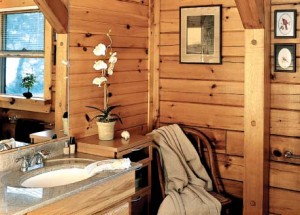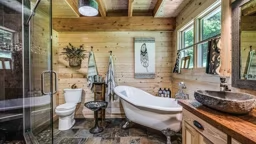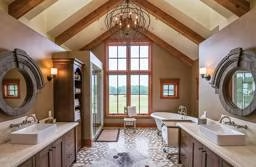Bath countertops can be anything from wood to ceramic tile or concrete. Laminates are probably the most underrated since they are often associated with cheap or “builder grade” construction. However, there are many high-quality laminates that offer a wide range of looks. In addition to cost advantages, laminates aren’t as hard or cold as concrete or tile. Custom poured colored concrete countertops are striking and can be made in interesting and unusual shapes. For a rustic countertop consider wood. Our ancestors used untreated wood for many counter surfaces. They maintained them by scrubbing them frequently with a stiff brush and letting them dry. Unless you enjoy scrubbing, a coating of several layers of polyurethane will keep counters dry and stain free. Granite, marble and synthetic materials like Corian also can be used for countertops. For a unique look, consider making countertops from slabs of stone. Flagstone, soapstone and slate are a few of the natural surfaces that make striking countertops. If the stone is porous, you’ll want to seal it to avoid rings and stains.
 What are the best bathroom-floor materials?
What are the best bathroom-floor materials? Ceramic tile and vinyl are the two most common materials for covering bath floors. Vinyl is inexpensive and easy to install, making it a good do-it-yourself job. Patterns that mimic slate, ceramic tile and natural rock are readily available and look great. Most people consider ceramic tile and slate “upscale” floor finishes. While most handy homeowners can install ceramic tile themselves, I’d get a pro to do the job. Be sure the installation crew seals surfaces, including the grout lines. (Unsealed grout discolors quickly and is miserable to clean.) Shower floors can be made from tile or slate. Construction begins by installing a vinyl liner that covers the floor and extends several inches up the walls. Only the drain passes through the liner, and it’s carefully sealed. A shower base of concrete or mortar is applied over the liner. This serves as the base for ceramic tile or slate.
We have a great view of the mountains from our second floor, and I’d like to see them from the bathroom. What are some design considerations I need to consider with my builder?
Putting windows in shower or bath areas isn’t difficult but presents unique concerns.
 Windows must be able to withstand high moisture levels and frequent wetting. Wood trim, as a rule, should be sealed with several coats of polyurethane. Building codes require that windows in bath areas have tempered glass. This hardened glass provides a margin of safety should someone slip and fall against it. In areas where privacy is a concern, you can specify “obscure” or frosted glass. Windows in bath areas offer one great plus, especially if there are exposed wood frames: natural ventilation. If you have your heart set on the view from the bathroom, go for it — work with your design team to make it happen. The only problem I can see is your water bill: When enjoying the mountain vistas, you may never want to leave the shower.
Windows must be able to withstand high moisture levels and frequent wetting. Wood trim, as a rule, should be sealed with several coats of polyurethane. Building codes require that windows in bath areas have tempered glass. This hardened glass provides a margin of safety should someone slip and fall against it. In areas where privacy is a concern, you can specify “obscure” or frosted glass. Windows in bath areas offer one great plus, especially if there are exposed wood frames: natural ventilation. If you have your heart set on the view from the bathroom, go for it — work with your design team to make it happen. The only problem I can see is your water bill: When enjoying the mountain vistas, you may never want to leave the shower.











